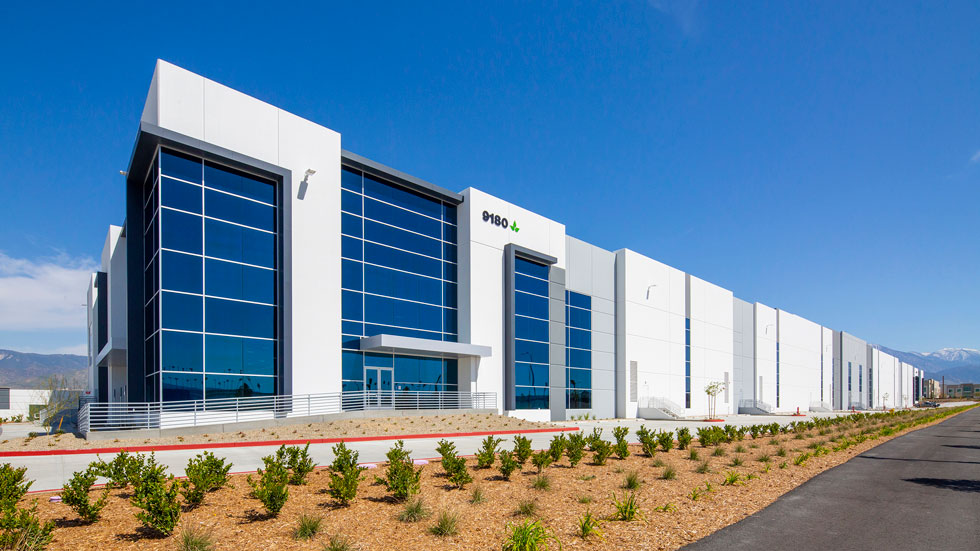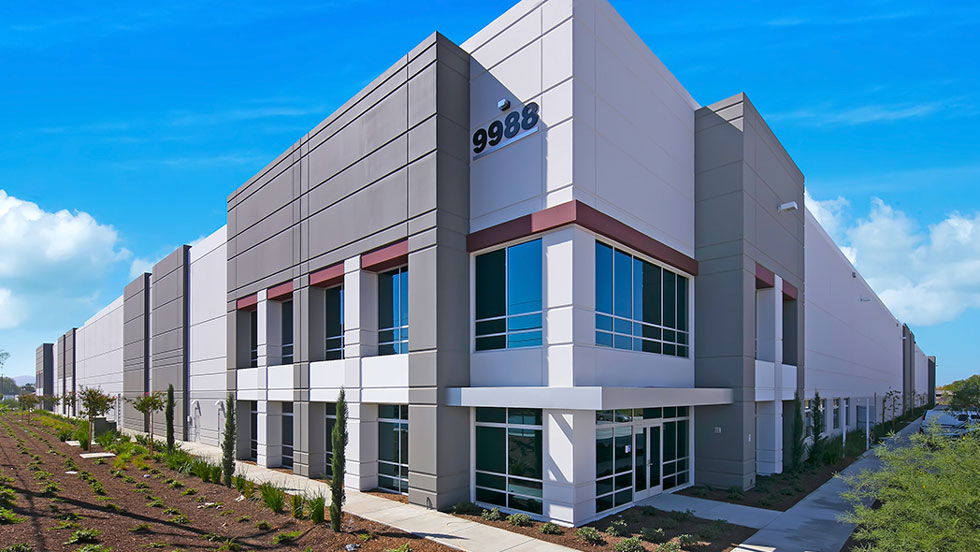Staggering demand for U.S. logistics facilities is helping fuel Duke Realty’s continued success.
As it marks its 50th anniversary this year, Duke Realty Corp. (NYSE: DRE) has much to celebrate—industrial vacancy rates are at record lows, rents are rising, and developers can’t build space fast enough to meet the booming demand.
The acceleration of e-commerce, combined with supply chain logjams, has driven demand for warehouse, distribution, and fulfillment space to never-before-seen levels. For Indianapolis-based Duke Realty, a pure-play logistics REIT, that combination resulted in a record-breaking year in 2021.
“It’s certainly been an interesting ride,” says Duke Realty Chairman and CEO Jim Connor, who joined the company in 1998 before taking the helm in 2016.
“I got into this crazy business about 40 years ago,” Connor, who is also Nareit’s First Vice Chair, says. “Across the country, industrial real estate was basically the same. Every building was around $30 a square foot and rent was $3 a foot.” Today, things are dramatically different. “Prices and rents are much higher. The demand is incredible. The size of the buildings has grown exponentially. Given the run that we’ve been on, it’s been fun,” he says.
Fueled by an insatiable appetite for space, Duke Realty’s core funds from operations (FFO) grew 13.8% in 2021, and for 2022, the company is projecting a 10.4% FFO increase. Occupancy of its in-service portfolio hit 98.1% amid unprecedented leasing activity of 33.5 million square feet. Rental rates also grew 35.3%, the highest annual record in Duke Realty’s history.
Meanwhile, Duke Realty is developing at a blistering speed. It completed 8.2 million square feet of development in 2021, of which 96% was leased as of March 31. It has more than $1.6 billion under development and a $1.55 billion pipeline for 2022, as it continues focusing on coastal tier-one markets and inland hubs.
Stress Test
The pandemic was a great stress test for the company, according to Connor. “U.S. GDP dropped 30% in 2020 when the pandemic started, and the world ‘came to an end.’ We collected 99.99% of our rents. We had no major bankruptcies or defaults. We adapted to the pandemic and continued to build buildings. We continued to lease space. We continued to serve our customers so they could serve their customers. We came through with flying colors,” he says. At the end of 2020, “we beat every earnings and guidance metric that we had put out at the beginning of the year.”
Duke Realty’s achievements have not gone unnoticed. “The company is doing extremely well,” says Green Street lead industrial analyst Vince Tibone.
“They’re very successful in their development, which is creating significant value. They pivoted their portfolio and moved more toward coastal markets, which are generally the best-performing markets in the sector. They’ve also done a really great job allocating capital and positioning their portfolio in today’s environment,” Tibone says.
Duke Realty will also benefit from future rent growth, Tibone says. Green Street anticipates industrial rents growing 13% nationally in 2022. “We think the operating environment is going to stay at record levels throughout 2022, because of the continued mismatch of supply and demand,” he notes.
Alice Chung, a vice president and senior analyst in the corporate finance group at Moody’s Investors Service, says Duke Realty is in a strong position to continue to benefit, given the fact that it has a geographically diverse portfolio. “That, in addition to the fact that its average in-place rents are still under market by 17% to 18%,” she says. “As those leases expire, Duke Realty is going to be able to capture very strong rent growth, which is what we’ve seen for consecutive quarters.”
And although the current macro-environment includes “a lot of noise with the ongoing conflict in Ukraine and inflationary pressures, the buffer that Duke Realty has is that their rents are still well below market,” Chung continues. “We still think they’re going to get a very good bump in rent growth this year.” STRATEGIC PIVOT
Industrial real estate has evolved over the decades, as has Duke Realty, which was founded in 1972. Back then, there were no national industrial developers or industrial REITs. It was a very local business. With $40,000 in capital, Phil Duke, John Rosebrough, and John Wynne built their first building in Indianapolis. In 1977, Duke Realty expanded into Cincinnati and added office properties to its portfolio. It became a REIT in 1986 and grew throughout the Midwest. The company went public in 1993.
Duke Realty later acquired Atlanta-based Weeks Realty Corp., giving it a strong presence in the Southeast. It continued growing in the West, South, and East.
Following numerous acquisitions, developments, and investments in new markets, new sectors followed including medical, retail, residential, and mixed use. Duke Realty grew to become one of the nation›s leading owners, managers, and developers of commercial real estate.
But as a diversified REIT, according to Connor, Duke Realty was trying to be all things to all people. When the global financial crisis hit in 2008-09, “that’s when we found out how good we really were at operating all these different businesses,” he says. “The reality is we weren’t that good. We didn’t have the appropriate scale. We didn’t have the depth in the teams that led those businesses. That’s what forced us to simplify our strategy.”
Starting in the mid-2000s, under Connor’s leadership, Duke Realty sold off its office, medical office, and other non-industrial real estate to become the largest domestic U.S. industrial REIT. A tremendous amount of repositioning, selling, and buying of assets, and development occurred.
“We completed a couple of $1 billion office portfolio sales,” Connor notes. Additionally, Duke Realty sold its medical office building assets for $3.1 billion. “We also completed a $1 billion industrial portfolio acquisition, and the rest was done through blocking and tackling—selling small portfolios, building more buildings, buying more buildings, one step at a time, and it took about seven years to complete the transformation,” Connor says.
Duke Realty completed approximately $14 billion of capital recycling, all while rebuilding the balance sheet, which had become over-levered going into the financial crisis. The repositioning culminated in two ratings upgrades to BBB+ and being added to the S&P 500.
“It’s been an amazing evolution,” Connor says. “Seeing the results that we’ve been able to achieve since 2017, I say to myself, we should have done it sooner. We should have done it faster. I don’t know that we necessarily could have, but that’s my one regret.”
Like all strategic transformations, Connor says there was an “appreciable level of doubt at the very beginning that we could do it without completely screwing up the company.”
Connor remembers sitting in a board meeting in 2010, outlining the strategic plan. Two board members said, “’This sounds great. Do you really think you can do it?’ There was a nagging voice saying, ‘Well, I think we can,’” Connor recalls. “That’s what we needed to do to survive and be successful. But like any significant goal you set, there’s always doubt about whether you’ll be able to achieve it. But if you don’t have a little bit of concern, then you’re really not stretching yourself. Our goal is to always be comfortably uncomfortable.”
Tibone says Duke Realty did well on its execution of simplifying the business and focusing solely on industrial, and definitely timed it well. “Since they exited the medical office business in 2017, industrial fundamentals and asset values have been on fire.”
Chung agrees. “Duke Realty started out with a mixed bag of assets,” she says. “Over the last 10-plus years they have honed their business strategy. I think investors value REITs that have more of a solo investment type, rather than a mix of everything, because the latter tends to add noise to earnings.”
Performance Drivers
Of the various factors fueling Duke Realty’s performance, e-commerce is the biggest driver, Connor says. He notes that it’s not just Amazon but Walmart, Target, and other retailers’ e-commerce platforms that are growing exponentially.
“They’re leveraging their store footprints and driving increased sales, and that will drive them to invest more in their logistics and supply chains,” Connor says. He believes e-commerce is still very much in the early innings, and companies will continue to require an abundance of space.
“And the space they’re taking to support their e-commerce initiatives isn’t 25-year-old buildings,” he notes. “It’s brand-new, state-of-the-art buildings, because they have the electrical power, clear height, and structural integrity to support the material-handling equipment and robotics.”
Another trend driving demand is “on-shoring” or “near-shoring,” as more companies bring manufacturing back from overseas and require more industrial space across the U.S.
Connor says “safety stock” is a newer term used by retailers and logistics companies, as they try to stockpile goods to protect against supply chain issues.
“Empty shelves are a capital offense for retailers,” Connor says. “That’s lost sales, lost revenue, and lost market share. Companies today aren’t carrying just two weeks of inventory; they’re carrying huge multiples of that and need more warehousing.”
Also buoying Duke Realty’s performance is the need for reverse logistics” facilities. That’s the return of goods sold through e-commerce platforms. “There’s a whole industry to take back returns as cost-effectively as possible, repurpose them, and put that back into the supply chain,” Connor explains.
Record Development
Duke Realty exceeded $1 billion in development starts and $1 billion in deliveries in 2021. The REIT is active across South Florida, Southern California, Seattle, New Jersey, and Savannah, Georgia.
“We’re virtually building as fast as we can and as much as we can,” Connor says.
And it’s not just greenfield development. Half of Duke Realty’s development is infill redevelopment in which it’s buying functionally obsolete properties, clearing the sites, doing environmental cleanup, and building last-mile, state-of-the-art logistics centers close to major population areas.
For example, Duke Realty acquired an old, multistory manufacturing facility in Marcus Hook, Pennsylvania, which sat vacant for 40 years. Part of it burned in a fire, and it has environmental issues. However, it’s an excellent infill, last-mile site that can reach roughly three million people within 30 minutes. Duke Realty will redevelop the site, building a high-quality logistics facility and creating jobs and tax revenue from the construction. Once leased, it will create permanent jobs and put the property back on the tax rolls.
Additional Runway
Industrial real estate is forecast to dominate in 2022, due to the spike in e-commerce and supply chain disruptions, and Connor forecasts another robust year for Duke Realty.
“I’m on record telling all of our investors that every major operational metric—leasing volume, occupancy, and rent escalation—are as good or better than they were in the fourth quarter of 2021,” Connor says.
However, that doesn’t mean there aren’t challenges. “There are storm clouds on the horizon,” Connor acknowledges. “What’s going on in Ukraine is horrific. Inflation challenges are troublesome to everybody. But, if you look at the health and well-being of our company, we’ll be just fine. It might not be easy, but we’ll continue to perform at a very high level. We have plenty of runway left in the industrial sector.”
Making an Impact
By focusing exclusively on industrial, Connor says Duke Realty has become a leader on many fronts. That also includes corporate responsibility initiatives like investing more than $2 billion in LEED-certified projects.
The company is also building smart buildings and adapting new technologies, including solar development and the use of electric vehicles. To that end, Duke Realty announced a program offering employees a forgivable $5,000 loan if they buy an electric vehicle and remain employed at Duke Realty for four years.
“We’re a very profitable company and we’re a big company,” Connor says. “That’s great, right? But it’s the softer things that we do. Things we do for the environment. Things we do for diversity, equity, and inclusion.”
Connor was the first REIT CEO to sign the CEO Action for Diversity & Inclusion pledge to advance diversity and inclusion in the workplace. “Everybody’s got a responsibility to generate a return for their shareholders,” Connor says. “But, there are not as many companies in today’s world—where there are many challenges—that try to make an impact and make the world a better place. I’m proud of our track record and our focus to continue to do that.”



